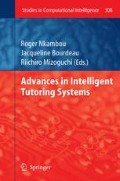Abstract
Bayesian networks are a formalism for reasoning under uncertainty that has been widely adopted in Artificial Intelligence (AI). Student modeling, i.e., the process of having an ITS build a model of relevant student’s traits/states during interaction, is a task permeated with uncertainty, which naturally calls for probabilistic approaches. In this chapter, I will describe techniques and issues involved in building probabilistic student models based on Bayesian networks and their extensions. I will describe pros and cons of this approach, and discuss examples from existing Intelligent Tutoring Systems that rely on Bayesian student models
Access this chapter
Tax calculation will be finalised at checkout
Purchases are for personal use only
Preview
Unable to display preview. Download preview PDF.
References
Arroyo, I., Woolf, B.: Inferring learning and attitudes from a Bayesian Network of log file data. In: 12th International Conference on Artificial Intelligence in Education, AIED 2005 (2005)
Bunt, A., Conati, C., Hugget, M., Muldner, K.: On Improving the Effectiveness of Open Learning Environments through Tailored Support for Exploration. In: 10th World Conference of Artificial Intelligence and Education, AIED 2001 (2001)
Buntine, W.: A Guide to the Literature on Learning Probabilistic Networks from Data. IEEE Transactions on Knowledge and Data Engineering 8(2), 195–210 (1996)
Chi, M.: Self-explaining: The dual processes of generating inference and repairing mental models. In: Glaser, R. (ed.) Advances in instructional psychology: Educational design and cognitive science, vol. (5), pp. 161–238. Lawrence Erlbaum Associates, Mahwah (2000)
Conati, C., Maclaren, H.: Empirically Building and Evaluating a Probabilistic Model of User Affect. Modeling and User-Adapted Interaction 19(3), 267–303 (2009)
Conati, C., Merten, C.: Eye-Tracking for User Modeling in Exploratory Learning Environments: an Empirical Evaluation. Knowledge Based Systems 20(6), 557–574 (2007)
Conati, C., Gertner, A., VanLehn, K.: Using Bayesian Networks to Manage Uncertainty in Student Modeling. Journal of User Modeling and User-Adapted Interaction 12(4), 371–417 (2002)
Conati, C., Merten, C., Muldner, K., Ternes, D.: Exploring Eye Tracking to Increase Bandwidth in User Modeling. In: Ardissono, L., Brna, P., Mitrović, A. (eds.) UM 2005. LNCS (LNAI), vol. 3538, pp. 357–366. Springer, Heidelberg (2005)
Corbett, A.T., Anderson, J.R.: Knowledge tracing: Modeling the acquisition of procedural knowledge. User Modeling and User-Adapted Interaction 4(4), 253–278 (1995)
Costa, P., McRae, R.: Four ways five factors are. Personality and Individual Differences 13, 653–665 (1992)
Dean, T., Kanazawa, K.: A Model for REasoning About Persistence and Causation. Computational Intelligence 5(3), 142–150 (1989)
Dempster, A., Laird, N., Rubin, D.: Maximization-likelihood from Incomplete Data via the EM Algorithm. Journal of Royal Statistical Society, Series B (1977)
D’Mello, S., Craig, S., Witherspoon, A., McDaniel, B., Graesser, A.: Automatic detection of learner’s affect from conversational cues. User Modeling and User-Adapted Interaction, 45–80 (2008)
Ferguson, K., Arroyo, Y., Mahadevan, S., Park Woolf, B., Barto, A.: Improving Intelligent Tutoring Systems: Using Expectation Maximization to Learn Student Skill Levels. In: Ikeda, M., Ashley, K.D., Chan, T.-W. (eds.) ITS 2006. LNCS, vol. 4053, pp. 453–462. Springer, Heidelberg (2006)
Henrion, M.: Some practical issues in constructing belief networks. In: 3rd Conference on Uncertainty in Artificial Intelligence, pp. 161–173 (1989)
Keeney, R.L., von Winterfeldt, D.: Eliciting probabilities from experts in complex technical problems. IEEE Transactions on Engineering Management 38, 191–201 (1991)
Martin, J., VanLehn, K.: Student assessment using Bayesian nets. International Journal of Human-Computer Studies 42, 575–591 (1995)
Mayo, M., Mitrovic, T.: Optimising ITS Behaviour with Bayesian Networks and Decision Theory. International Journal of Artificial Intelligence in Education 12, 124–153 (2001)
Mislevy, R.: Probability-based inference in cognitive diagnosis. In: Nichols, P., Chipman, S., Brennan, R. (eds.) Cognitive Diagnostic Assessment, pp. 43–71. Erlbaum, Hillsdale (1995)
Moore, A., Wong, W.: Optimal Reinsertion: A New Search Operator for Accelerated and More Accurate Bayesian Network Structure Learning. In: ICML 2003, pp. 552–559 (2003)
Murray, C., VanLehn, K., Mostov, J.: Looking Ahead to Select Tutorial Actions: A Decision-Theoretic Approach. International Journal of Artificial Intelligence in Education 14(3-4), 235–278 (2004)
Pearl, J.: Probabilistic Reasoning in Intelligent Systems. Morgan Kaufmann, San Mateo (1988)
Reye, J.: Two-phase updating of student models based on dynamic belief networks. In: Goettl, B.P., Halff, H.M., Redfield, C.L., Shute, V.J. (eds.) ITS 1998. LNCS, vol. 1452, pp. 274–283. Springer, Heidelberg (1998)
Russel, S., Norvig, P.: Artificial Intelligence - A Modern Approach, 3rd edn. Prentice Hall, Englewood Cliffs (2010)
VanLehn, K., Niu, Z.: Bayesian student modeling, user interfaces and feedback: A sensitivity analysis. International Journal of Artificial Intelligence in Education 12, 154–184 (2001)
Zapata-Rivera, D., Greer, J.: Interacting with Inspectable Bayesian Student Models. International Journal of Artificial Intelligence in Education 14(2), 127–163 (2004)
Zhou, X., Conati, C.: Inferring User Goals from Personality and Behavior in a Causal Model of User Affect. In: UI 2003, International Conference on Intelligent User Interfaces, pp. 211–281. ACM Press, New York (2003)
Author information
Authors and Affiliations
Editor information
Editors and Affiliations
Rights and permissions
Copyright information
© 2010 Springer-Verlag Berlin Heidelberg
About this chapter
Cite this chapter
Conati, C. (2010). Bayesian Student Modeling. In: Nkambou, R., Bourdeau, J., Mizoguchi, R. (eds) Advances in Intelligent Tutoring Systems. Studies in Computational Intelligence, vol 308. Springer, Berlin, Heidelberg. https://doi.org/10.1007/978-3-642-14363-2_14
Download citation
DOI: https://doi.org/10.1007/978-3-642-14363-2_14
Publisher Name: Springer, Berlin, Heidelberg
Print ISBN: 978-3-642-14362-5
Online ISBN: 978-3-642-14363-2
eBook Packages: EngineeringEngineering (R0)

